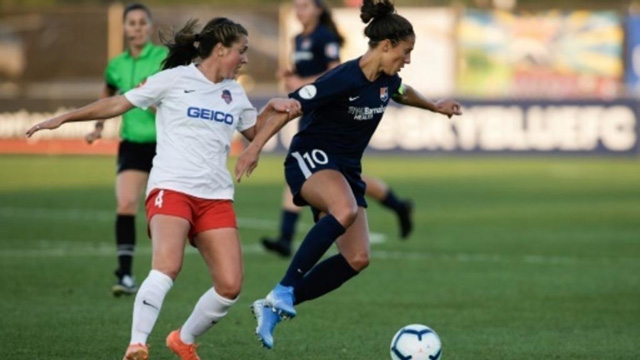
New York, United States | AFP | The US women’s football team is the best on the planet, but the sport’s domestic league is virtually unknown.
Players, organisers and fans hope that is about to change as the National Women’s Soccer League (NWSL) is looking to capitalise on the national team’s triumph at the World Cup in July — and it could already be seeing a bounce.
“We’re seeing a huge wave from the World Cup. In the NWSL attendances have been up, so it’s great to see,” two-time world and Olympic champion Carli Lloyd told a group of reporters.
Lloyd, 37, spoke after playing a match for New Jersey club side Sky Blue FC.
More than a half hour after the game, Sky Blue FC players were still busy signing programmes, posters and calendars for the hundreds of young fans who lined up to meet their heroes.
“There’s a lot of people that still have no idea that there is a NWSL women’s league,” Lloyd said, and explained what the players could do to help change that.
“Changing people’s lives. Going down the line, signing autographs, taking selfies. A kid sees that. ‘Wow, I just got a selfie with Carli. I want to come back.’ That’s really what it’s all about,” she added.
A capacity crowd of 5,000 packed into Yurcak Field stadium last week for Lloyd’s first Sky Blue FC game since she returned from the World Cup in France.
The hosts lost 1-0 to the Washington Spirit.
The same night in Seattle, the Portland Thorns thrashed the Houston Dash 5-0 in front of a crowd of more than 22,000, just short of the largest-ever attendance for an NWSL match.
“Sometimes in the NWSL you don’t play in front of big crowds, so I feel like it’s awesome to have two games back-to-back where it’s been a sell-out crowd, said national team member Rose Lavelle, who plays for the Washington Spirit.
“Hopefully, it will just keep continuing,” she said.
Many of the spectators AFP spoke to were watching Sky Blue play for the first time, highlighting the growing interest in the women’s game following the national team’s successful defence of their World Cup crown.
– Sponsorship –
In addition to their 2019 and 2015 titles, the US team also triumphed in 1999 and at the sport’s 1991 inaugural championship.
“I think women sports in general are catching on and being more popular,” said PJ Petrow, who has been coaching girls’ football for 25 years.
“I don’t think this win was any bigger than any others. It’s just because of social media and a lot of stuff going on it’s attracted a lot more people to the sport,” she added.
Interest in US women’s football has tended to soar after each of the country’s four World Cup titles before dipping again later, but the NWSL is determined to make this year’s bump last.
The league suffered a blow earlier this year when the A&E network, a long-time broadcaster and an NWSL shareholder, suddenly withdrew its support.
Then, in the midst of the World Cup fever, major sports broadcaster ESPN announced that it would showcase 14 matches this season, which began in April and runs through the middle of October.
One of them, the Chicago Red Stars versus the North Carolina Courage, attracted an average of 149,000 viewers — the biggest audience in three years.
And beer manufacturer Budweiser signed a multi-year deal to sponsor the league.
“There’s definitely a lot of excitement in the league and the sponsors want to be a part of that,” Theresa Ferguson, brand management director for the NWSL, told AFP.
Six years after it was formed, the NWSL is already the most successful professional women’s league in the United States. Two other leagues ran from 2001-2003 and 2009-2013 before disbanding.
The NWSL’s future is fragile, though. In 2017, two out of the league’s 10 teams disappeared due to a lack of funds.
The league also fails to offer the kind of money available in other countries. The maximum salary is just $46,200 (41,700 euros) per year. In contrast, Norwegian star Ada Hegerberg makes 400,000 euros ($442,900) playing for Olympique Lyonnais.
“What’s unique right now is that it feels like more than the league,” Sky Blue’s general manager Alyse LaHue said.
“We’re seeing a lot of teams and owners coming together collectively and saying, ‘We’re in a really important moment right now. What are we going to do as a league and as individual teams to capitalise on this?'”
 The Independent Uganda: You get the Truth we Pay the Price
The Independent Uganda: You get the Truth we Pay the Price



